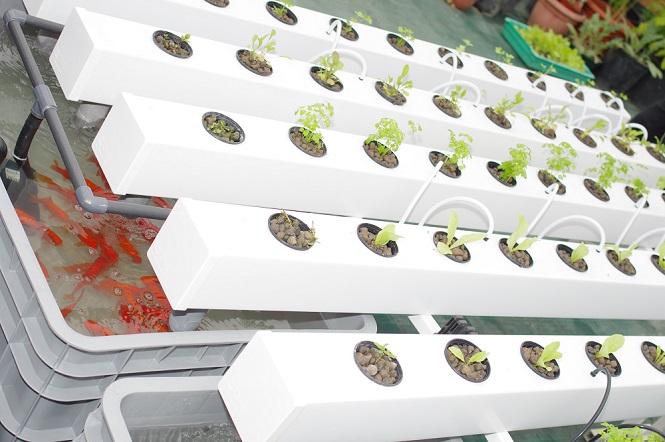 Aquaponic farming has always intrigued me. As I am always looking for new ways to garden that are healthy for my family and the environment and aquaponic farming doesn’t use chemical pesticides of any kind, I was – unsurprisingly – interested in learning more about it.
Aquaponic farming has always intrigued me. As I am always looking for new ways to garden that are healthy for my family and the environment and aquaponic farming doesn’t use chemical pesticides of any kind, I was – unsurprisingly – interested in learning more about it.
What is aquaponic farming?
Basically, aquaponic farming is combining aquaculture (which is raising fish) and hydroponics (which is growing plants without soil) in one integrated system. The fish waste provides the organic food for the plants, and the plants provide a natural filter for the water the fish live in. The other piece of the symbiotic relationship that makes aquaponic farming successful is the beneficial bacteria that converts the fish wastes into nutrients for the plant to use. In combining both systems, aquaponics capitalizes on the benefits of aquaculture and hydroponics while eliminating the drawbacks of each.What are some benefits of aquaponic farming?
- There are no weeds to pull.
- Auaponics uses the nutrient rich water from the fish that otherwise would be considered a waste product or need to be filtered in a costly manner.
- Aquaponics uses up to 90 percent less water than conventional farming does.
- With aquaponic farming, no pesticides or herbicides can be used, which makes the whole process healthier and safer.
- You can group crops year-round, if your climate permits or if you are growing in a greenhouse.
- Since water is part of the aquaponic system, it’s pretty difficult to under-water or over-water.
- Gardening chores are cut down dramatically or eliminated. The aquaponic grower is able to focus on the fun things, like feeding the fish and harvesting the plants.
Are there any disadvantages of aquaponic farming?
The main downsides to aquaponics farming that I came across during my research were that the system consumes energy and you need to provide the fish with food.Energy consumption. Some detractors of the aquaponic method contend a lot of energy required for this type of farming. There are pumps needed to push the water out of the fish tank and into the grow beds. Depending on the type of fish you have and where your system is located, you need to keep the water at a consistent temperature. And you may or may not need grow lights, again, depending on your location. As a counter to this argument against aquaponic farming, a number of farmers utilize solar energy to run their systems.
Fish food. Some critics of aquaponics farming say this method is still basically a Confined Animal Feeding Operation (CAFO) and is contributing to overfishing since most fish feed contains wild-caught fish meal. I did find an organic fish food option made by AquaOrganic. AquaOrganic Omnivorous Fish Feed is made from non-GMO, USDA-certified organic ingredients and contains no fish meal or soy.
To find out more information about a really interesting certified organic aquaponics farm in St. Paul, Minnesota, check out Urban Organics. They have turned an old brewery building into a year-round aquaponics farm.